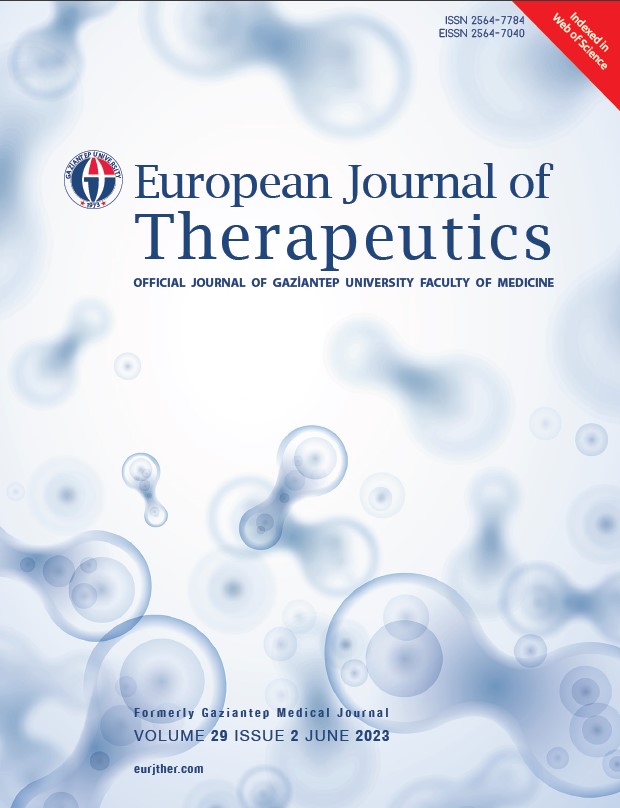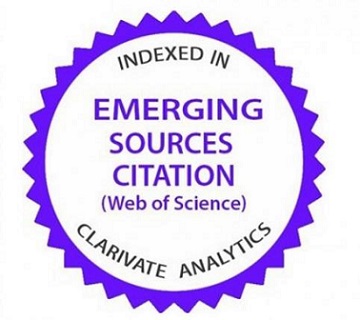Correlation of Diffusion-weighted MR imaging and FDG PET/CT in the Diagnosis of Metastatic Lymph Nodes of Head and Neck Malignant Tumors
DOI:
https://doi.org/10.58600/eurjther.20232902-450.yKeywords:
Diffusion-weighted magnetic resonance imaging, head and neck cancer, squamous cell carcinoma, Fluoro-2-deoxy-d-glucose-Positron emission tomographyAbstract
Objectives: The aim of this study was to investigate the efficacy of DW-MRI as a reliable imaging modality for detecting metastatic neck lymph nodes of head and neck SCC.
Methods: 32 patients underwent FDG PET/CT and diffusion-weighted MRI were evaluated. Histopathologic analysis of lymph node metastases was used as the gold standard for assessment. We analyzed differences in sensitivity, specificity, accuracy, positive predictive value and negative predictive value among the imaging modalities using the Chi-square test. Their discriminative power evaluated using the Receiver-Operating Characteristic curve and calculation of the area under the curve. The correlation between ADCmin and SUVmax was calculated using the Spearman test. SPSS 24 was used for statistical analyses. P value of 0.05 indicates a statistically significant difference.
Results: A total of 32 patients with 50 neck dissections with head and neck SCC included. Sensitivity, specificity, accuracy, positive and negative predictive value of neck palpation was %72, %60, %70, %62 and %80 respectively. Sensitivity, specificity, accuracy, positive and negative predictive value of DW-MRI was %87,5, %96,2, %92, %95,5 and %89,3 respectively, according to ADCmin cutoff value 0.82×10-3s/mm2 . Sensitivity, specificity, accuracy, positive and negative predictive value of FDG-PET/CT was %91,7, %100, %96, %100 and %92,9 , respectively ,according to SUVmax cutoff value 3.4. For all neck dissections, there was a statistically significant inverse correlation between ADCmin and SUVmax (P<001).
Conclusion: DW-MRI is reliable as detecting cervical lymph node metastases as FDG-PET/CT. DWI and FDG PET/CT could play a complementary role in clinical assessment.
The original version of this article, unfortunately contained an error. The name of Aslıhan Semiz Oysu, who is one of the co-authors and took part in every stage of the study, was not inadvertently added to the author list by the corresponding author. The author apologizes for this confusion. Given in this article are the correct author names.
Correction to: https://doi.org/10.58600/eurjther1878
Metrics
References
Gormley M, Creaney G, Schache A, Ingarfield K (2022) Conway DI. Reviewing the epidemiology of head and neck cancer: definitions, trends and risk factors. Br Dent J. 233(9):780-786. https://doi.org/10.1038/s41415-022-5166-x
Dyba T, Randi G, Bray F, et al (2021) The European cancer burden in 2020: Incidence and mortality estimates for 40 countries and 25 major cancers. Eur J Cancer. 157:308-347. https://doi.org/10.1016/j.ejca.2021.07.039
Rogers SJ, Harrington KJ, Rhys-Evans P, O-Charoenrat P, Eccles SA (2005) Biological significance of c-erbB family oncogenes in head and neck cancer. Cancer Metastasis Rev. 24(1):47-69. https://doi.org/10.1007/s10555-005-5047-1
Di Martino E, Nowak B, Hassan HA, et al (2000) Diagnosis and Staging of Head and Neck Cancer. Arch Otolaryngol Neck Surg. 126(12):1457. https://doi.org/10.1001/archotol.126.12.1457
Sakamoto J, Yoshino N, Okochi K, et al (2009) Tissue characterization of head and neck lesions using diffusion-weighted MR imaging with SPLICE. Eur J Radiol. 69(2):260-268. https://doi.org/10.1016/j.ejrad.2007.10.008
Wang J, Takashima S, Takayama F, et al (2001) Head and Neck Lesions: Characterization with Diffusion-weighted Echo-planar MR Imaging. Radiology. 220(3):621-630. https://doi.org/10.1148/radiol.2202010063
Aksoy F, Veyseller B, Binay O, Apuhan T, Yildirim YS, Ozturan O (2010) Patterns of cervical metastasis from squamous cell carcinoma of the head and neck. Kulak Burun Bogaz Ihtis Derg. 20(5):249-254.
Ying M, Bhatia KSS, Lee YP, Yuen HY, Ahuja AT (2013) Review of ultrasonography of malignant neck nodes: greyscale, Doppler, contrast enhancement and elastography. Cancer Imaging. 13(4):658-669. https://doi.org/10.1102/1470-7330.2013.0056
Meng W, Xing P, Chen Q, Wu C (2013) Initial experience of acoustic radiation force impulse ultrasound imaging of cervical lymph nodes. Eur J Radiol. 82(10):1788-1792. https://doi.org/10.1016/j.ejrad.2013.05.039
Cho JK, Hyun SH, Choi N, et al (2015) Significance of Lymph Node Metastasis in Cancer Dissemination of Head and Neck Cancer. Transl Oncol. 8(2):119-125. https://doi.org/10.1016/j.tranon.2015.03.001
Mathers CD, Shibuya K, Boschi-Pinto C, Lopez AD, Murray CJL (2002) Global and regional estimates of cancer mortality and incidence by site: I. Application of regional cancer survival model to estimate cancer mortality distribution by site. BMC Cancer. 2(1):36. https://doi.org/10.1186/1471-2407-2-36
Sumi M, Sakihama N, Sumi T, Morikawa M (2003) Discrimination of Metastatic Cervical Lymph Nodes with Diffusion-Weighted MR Imaging in Patients with Head and Neck Cancer. Am J Neuroradiol. 24:1627-1634.
Abdel Razek AAK, Soliman NY, Elkhamary S, Alsharaway MK, Tawfik A (2006) Role of diffusion-weighted MR imaging in cervical lymphadenopathy. Eur Radiol. 16(7):1468-1477. https://doi.org/10.1007/s00330-005-0133-x
Vandecaveye V, De Keyzer F, Vander Poorten V, et al (2009) Head and Neck Squamous Cell Carcinoma: Value of Diffusion-weighted MR Imaging for Nodal Staging. Radiology. 251(1):134-146. https://doi.org/10.1148/radiol.2511080128
Huisman TAGM, Loenneker T, Barta G, et al (2006) Quantitative diffusion tensor MR imaging of the brain: field strength related variance of apparent diffusion coefficient (ADC) and fractional anisotropy (FA) scalars. Eur Radiol. 16(8):1651-1658. https://doi.org/10.1007/s00330-006-0175-8
Srinivasan A, Dvorak R, Perni K, Rohrer S, Mukherji SK (2008) Differentiation of Benign and Malignant Pathology in the Head and Neck Using 3T Apparent Diffusion Coefficient Values: Early Experience. Am J Neuroradiol. 29(1):40-44. https://doi.org/10.3174/ajnr.A0743
Brouwer J, Senft A, de Bree R, et al (2006) Screening for distant metastases in patients with head and neck cancer: Is there a role for 18FDG-PET? Oral Oncol. 42(3):275-280. https://doi.org/10.1016/j.oraloncology.2005.07.009
Paulus P, Sambon A, Vivegnis D, et al (1998) 18 FDG-PET for the assessment of primary head and neck tumors: Clinical, computed tomography, and histopathological correlation in 38 patients. Laryngoscope. 108(10):1578-1583. https://doi.org/10.1097/00005537-199810000-00029
Kresnik E, Mikosch P, Gallowitsch H, et al (2001) Evaluation of head and neck cancer with 18F-FDG PET: a comparison with conventional methods. Eur J Nucl Med. 28(7):816-821. https://doi.org/10.1007/s002590100554
Ng SH, Yen TC, Liao CT, et al (2005) 18F-FDG PET and CT/MRI in oral cavity squamous cell carcinoma: A prospective study of 124 patients with histologic correlation. J Nucl Med. 46(7):1136-1143.
Murakami R, Uozumi H, Hirai T, et al (2007) Impact of FDG-PET/CT Imaging on Nodal Staging for Head-And-Neck Squamous Cell Carcinoma. Int J Radiat Oncol. 68(2):377-382. https://doi.org/10.1016/j.ijrobp.2006.12.032
Sun R, Tang X, Yang Y, Zhang C (2015) 18FDG-PET/CT for the detection of regional nodal metastasis in patients with head and neck cancer: A meta-analysis. Oral Oncol. 51(4):314-320. https://doi.org/10.1016/j.oraloncology.2015.01.004
Kitajima K, Suenaga Y, Minamikawa T, et al (2015) Clinical significance of SUVmax in 18F-FDG PET/CT scan for detecting nodal metastases in patients with oral squamous cell carcinoma. Springerplus. 4(1):718. https://doi.org/10.1186/s40064-015-1521-6
Nakamatsu S, Matsusue E, Miyoshi H, Kakite S, Kaminou T, Ogawa T (2012) Correlation of apparent diffusion coefficients measured by diffusion-weighted MR imaging and standardized uptake values from FDG PET/CT in metastatic neck lymph nodes of head and neck squamous cell carcinomas. Clin Imaging. 36(2):90-97. https://doi.org/10.1016/j.clinimag.2011.05.002
Downloads
Published
How to Cite
License
Copyright (c) 2023 European Journal of Therapeutics

This work is licensed under a Creative Commons Attribution-NonCommercial 4.0 International License.
The content of this journal is licensed under a Creative Commons Attribution-NonCommercial 4.0 International License.


















